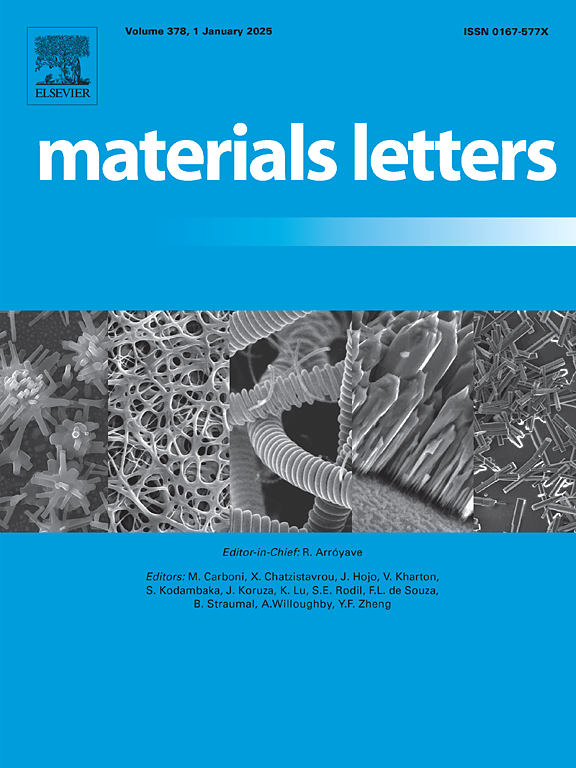Preparation of 3D carbon nanonets from SDBS in concentrated salt system
IF 2.7
4区 材料科学
Q3 MATERIALS SCIENCE, MULTIDISCIPLINARY
引用次数: 0
Abstract
The synthesis protocol utilized sodium dodecylbenzene sulfonate (80 × CMC) as carbon precursor combined with 100 g NaCl to construct a concentrated SDBS/NaCl templating system. Controlled carbonization at 800 °C for 2 h produced 3D carbon nanonets, which were systematically characterized through scanning electron microscopy (SEM), X-ray photoelectron spectroscopy (XPS), Fourier-transform infrared spectroscopy (FT-IR), Raman spectroscopy, and X-ray diffraction (XRD). Structural analyses revealed an amorphous carbon matrix with hierarchical porosity and partial graphitic ordering, while infrared spectroscopy identified characteristic surface functional groups through distinct vibrational modes: C![]() C (1475 cm−1), C
C (1475 cm−1), C![]() O (1725 cm−1), and C
O (1725 cm−1), and C![]() O (1033.5 cm−1) bonds. The 3D carbon nanonets demonstrated methylene blue adsorption capacities reaching 158 mg/g under 500 mg/L concentration conditions. Notably, the NaCl template exhibited recyclability through aqueous dissolution–recrystallization cycles, enabling repeatable batch synthesis of three-dimensional carbon networks in high-salinity environments. This template recovery mechanism provides critical technical parameters for scaling production processes while maintaining structural consistency across fabrication batches, establishing fundamental guidelines for industrial implementation of salt-templated carbon nanomaterial manufacturing. The SDBS/NaCl surfactant-assisted salt templating system was innovatively employed to engineer carbon nanonets, establishing a novel methodology for nanostructured material synthesis.
O (1033.5 cm−1) bonds. The 3D carbon nanonets demonstrated methylene blue adsorption capacities reaching 158 mg/g under 500 mg/L concentration conditions. Notably, the NaCl template exhibited recyclability through aqueous dissolution–recrystallization cycles, enabling repeatable batch synthesis of three-dimensional carbon networks in high-salinity environments. This template recovery mechanism provides critical technical parameters for scaling production processes while maintaining structural consistency across fabrication batches, establishing fundamental guidelines for industrial implementation of salt-templated carbon nanomaterial manufacturing. The SDBS/NaCl surfactant-assisted salt templating system was innovatively employed to engineer carbon nanonets, establishing a novel methodology for nanostructured material synthesis.

浓盐体系中SDBS制备三维碳纳米
合成方案以十二烷基苯磺酸钠(80 × CMC)为碳前驱体,结合100 g NaCl构建浓SDBS/NaCl模板体系。在800℃下控制碳化2 h,生成三维碳纳米,通过扫描电子显微镜(SEM)、x射线光电子能谱(XPS)、傅里叶变换红外光谱(FT-IR)、拉曼光谱和x射线衍射(XRD)对其进行了系统的表征。结构分析表明,碳基体具有分层孔隙和部分石墨有序,而红外光谱通过不同的振动模式识别出特征的表面官能团:CC (1475 cm−1),CO (1725 cm−1)和CO (1033.5 cm−1)键。在浓度为500 mg/L的条件下,三维纳米碳对亚甲基蓝的吸附量达到158 mg/g。值得注意的是,NaCl模板通过水溶液溶解-再结晶循环表现出可循环性,从而在高盐度环境下可重复批量合成三维碳网络。这种模板回收机制为规模化生产过程提供了关键的技术参数,同时保持了制造批次之间的结构一致性,为盐模板碳纳米材料制造的工业实施建立了基本指导方针。创新地采用SDBS/NaCl表面活性剂辅助盐模板系统来设计碳纳米,建立了一种新的纳米结构材料合成方法。
本文章由计算机程序翻译,如有差异,请以英文原文为准。
求助全文
约1分钟内获得全文
求助全文
来源期刊

Materials Letters
工程技术-材料科学:综合
CiteScore
5.60
自引率
3.30%
发文量
1948
审稿时长
50 days
期刊介绍:
Materials Letters has an open access mirror journal Materials Letters: X, sharing the same aims and scope, editorial team, submission system and rigorous peer review.
Materials Letters is dedicated to publishing novel, cutting edge reports of broad interest to the materials community. The journal provides a forum for materials scientists and engineers, physicists, and chemists to rapidly communicate on the most important topics in the field of materials.
Contributions include, but are not limited to, a variety of topics such as:
• Materials - Metals and alloys, amorphous solids, ceramics, composites, polymers, semiconductors
• Applications - Structural, opto-electronic, magnetic, medical, MEMS, sensors, smart
• Characterization - Analytical, microscopy, scanning probes, nanoscopic, optical, electrical, magnetic, acoustic, spectroscopic, diffraction
• Novel Materials - Micro and nanostructures (nanowires, nanotubes, nanoparticles), nanocomposites, thin films, superlattices, quantum dots.
• Processing - Crystal growth, thin film processing, sol-gel processing, mechanical processing, assembly, nanocrystalline processing.
• Properties - Mechanical, magnetic, optical, electrical, ferroelectric, thermal, interfacial, transport, thermodynamic
• Synthesis - Quenching, solid state, solidification, solution synthesis, vapor deposition, high pressure, explosive
 求助内容:
求助内容: 应助结果提醒方式:
应助结果提醒方式:


